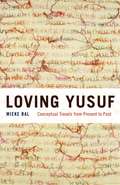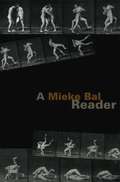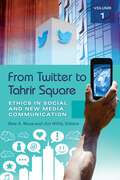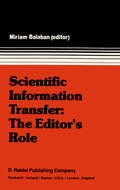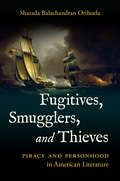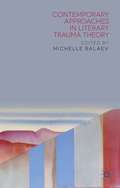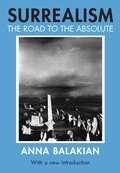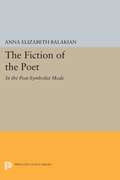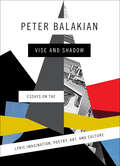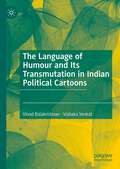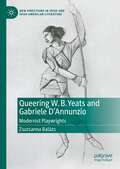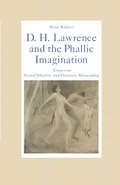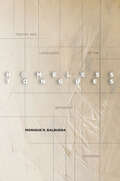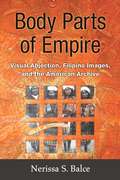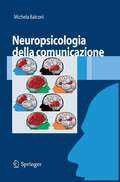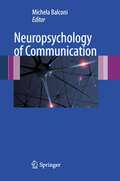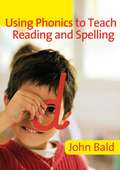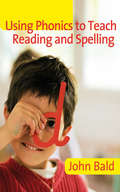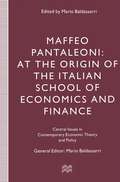- Table View
- List View
Loving Yusuf: Conceptual Travels from Present to Past (Afterlives of the Bible)
by Mieke BalWhen Mieke Bal reread the story of Joseph and Potiphar’s wife as an adult, she was struck by differences between her childhood memories of a moral tale and what she read today. In Loving Yusuf¸ Bal seeks to resolve this clash between memory and text, using the same story, in which Joseph spurns the advance of his master’s wife who then falsely accuses him of rape, as her point of departure. She juxtaposes the Genesis tale to the rather different version told in the Qur’an and the depictions of it by Rembrandt and explores how Thomas Mann’s great retelling in Joseph and His Brothers reworks these versions. Through this inquiry she develops concepts for the analysis of texts that are both strange and overly familiar—culturally remote yet constantly retold. As she puts personal memories in dialogue with scholarly exegesis, Bal asks how all of these different versions complicate her own and others’ experience of the story, and how the different truths of these texts in their respective traditions illuminate the process of canonization.
A Mieke Bal Reader
by Mieke BalMieke Bal has had a significant impact on every field she has touched, from Old Testament scholarship and narratology to critical methods and visual culture. This brilliant and controversial intellectual invariably performs a high-wire act at the point where critical issues and methods intersect—or collide. She is deeply interested in the problems of cultural analysis across a range of disciplines. A Mieke Bal Reader brings together for the first time a representative collection of her work that distills her broad interests and areas of expertise. This Reader is organized into four parts, reflecting the fields that Bal has most profoundly influenced: literary study, interdisciplinary methodology, visual analysis, and postmodern theology. The essays include some of Bal’s most characteristic and provocative work, capturing her at the top of her form. “Narration and Focalization,” for example, provides the groundwork for Bal’s ideas on narrative, while “Reading Art?” clearly outlines her concept of reading images. “Religious Canon and Literary Identity” reenvisions Bal’s own work at the intersection of theology and cultural analysis, while “Enfolding Feminism” argues for a new feminist rallying cry that is not a position but a metaphor. More than a dozen other essays round out the four sections, each of which is interdisciplinary in its own right: the section devoted to literature, for instance, ranges widely over psychoanalysis, theology, photography, and even autobiography. A Mieke Bal Reader is the product of a capacious intellect and a sustained commitment to critical thinking. It will prove to be instructive, maddening, and groundbreaking—in short, all the hallmarks of intellectual inquiry at its best.
From Twitter to Tahrir Square [2 volumes]: Ethics in Social and New Media Communication [2 volumes]
by Bala A. Musa and Jim WillisThis timely guide examines the influence of social media in private, public, and professional settings, particularly the ethical implications of the cultural changes and trends created by their use.In the quest for quick dissemination of information, web users and content providers find both opportunity and liability in digital broadcasts. Examples abound: Twitter members tap into news reports well in advance of traditional print media, but stories are prone to inaccuracies and misinformation; Facebook shares useful data mined from member profiles, but this sharing often compromises privacy. It is no surprise that use of social media gives rise to a host of moral dilemmas never before encountered. This book sheds light on the effects of this new medium on the individual and society.Through two volumes chock full of topics found in news headlines everyday, the authors look at evolving trends in social media and their impact on privacy, politics, and journalism. The first volume explores the role of this technology on national and international security. Volume 2 focuses on the individual as both a producer and consumer of internet content, showing how the media itself is changing notions of self-identity, relationships, and popular culture. The book's content covers such topics as individual and community psychology, citizen journalism, and corporate technology.
Scientific Information Transfer: Proceedings of the First International Conference of Scientific Editors, April 24–29, 1977, Jerusalem
by M. BalabanIt was Faraday who in 1821 said that there are three necessary stages of useful research. The first to begin it, the second to· end it, and the third 1 to publish it. There has since indeed been so much research and publication that we have become increasingly alarmed by the galloping proliferation of scientific information produced in relation to the user's ability to retrieve and consume it effectively, conveniently and creatively. In 1948, to deal with this concern, the Royal Society Scientific Infor 1 mation Conference held in London spanned the whole realm of scientific in formation. Sir Robert Robinson, President of the Royal Society, in his open ing address noted that "the study of scientific information services in all its ramifications has enormous scope", and the London conference dealt with scientific publication, format, editorial policy, subject grouping, organiza tion, abstracting, reviews, classification, indexing and training of infor mation officers. It was about this time that information science began to develop more on the retrieval end, so it seems logical that the first editors' group founded in 1949 was ICSU AB, the International Council of Scientific Unions Abstract ing Board. In 1958 the National Academy of Sciences International Conference of 2 Scientific Information in Washington limited its interests and expanded on the later phases of the life cycle of information - storage and retrieval.
Fugitives, Smugglers, and Thieves: Piracy and Personhood in American Literature
by Sharada Balachandran OrihuelaIn this book, Sharada Balachandran Orihuela examines property ownership and its connections to citizenship, race and slavery, and piracy as seen through the lens of eighteenth- and nineteenth-century American literature. Balachandran Orihuela defines piracy expansively, from the familiar concept of nautical pirates and robbery in international waters to postrevolutionary counterfeiting, transnational slave escape, and the illegal trade of cotton across the Americas during the Civil War. Weaving together close readings of American, Chicano, and African American literature with political theory, the author shows that piracy, when represented through literature, has imagined more inclusive and democratic communities than were then possible in reality. The author shows that these subjects are not taking part in unlawful acts only for economic gain. Rather, Balachandran Orihuela argues that piracy might, surprisingly, have served as a public good, representing a form of transnational belonging that transcends membership in any one nation-state while also functioning as a surrogate to citizenship through the ownership of property. These transnational and transactional forms of social and economic life allow for a better understanding of the foundational importance of property ownership and its role in the creation of citizenship.
Contemporary Approaches in Literary Trauma Theory
by Michelle BalaevThis edited collection argues that trauma in literature must be read through a theoretical pluralism that allows for an understanding of trauma's variable representations that include yet move beyond the concept of trauma as pathological and unspeakable.
Surrealism: The Road to the Absolute
by Anna BalakianFirst published in 1959, Surrealism remains the most readable introduction to the French surrealist poets Apollinaire, Breton, Aragon, Eluard, and Reverdy. Providing a much-needed overview of the movement, Balakian places the surrealists in the context of early twentieth-century Paris and describes their reactions to symbolist poetry, World War I, and developments in science and industry, psychology, philosophy, and painting. Her coherent history of the movement is enhanced by her firsthand knowledge of the intellectual climate in which some of these poets worked and her interviews with Reverdy and Breton. In a new introduction, Balakian discusses the influence of surrealism on contemporary poetry. This volume includes photographs of the poets and reproductions of paintings by Ernst, Dali, Tanguy, and others.
The Fiction of the Poet: In the Post-Symbolist Mode
by Anna Elizabeth BalakianAddressing all readers who value the beauty of language, Anna Balakian examines the work of five twentieth-century poets--Yeats, Valry, Rilke, Stevens, and Guilln--to show how the linguistic richness of the symbolist tradition continued well into the modern period. These writers, all of whom learned the poetry of language from Mallarm, compensated for the disappearance of metaphysical inclinations in early twentieth-century poetry by instituting a poetic fiction. Balakian finds the immersion of the "I" and its altered reflection in the work of art to be a common feature of their poetry, and explores how they replaced the conventional meaning of signifiers grown stale, such as the abused word "poet," which became musician, artist, dancer, acrobat, mime, tapestry weaver, rider of the earth and the skies. In the works of these poets, the symbol evolved into a selective system of communication that identified implicitly the realms of human dilemma in regard to time, space, place, and reality in an indifferent universe. Balakian explains how the poets made language posit the major problems of existence and survival through metaphors of transition and, with the polysemy of their discourse, spoke to each reader on his or her terms. Like a serial musical composition, this literary interpretation interweaves leitmotifs from one writer to another, creating a basic cohesion while revealing variations and transformations in their poetry.Originally published in 1992.The Princeton Legacy Library uses the latest print-on-demand technology to again make available previously out-of-print books from the distinguished backlist of Princeton University Press. These editions preserve the original texts of these important books while presenting them in durable paperback and hardcover editions. The goal of the Princeton Legacy Library is to vastly increase access to the rich scholarly heritage found in the thousands of books published by Princeton University Press since its founding in 1905.
Vise and Shadow: Essays on the Lyric Imagination, Poetry, Art, and Culture
by Peter BalakianPeter Balakian is a renowned poet, scholar, and memoirist; but his work as an essayist often prefigures and illuminates all three. "I think of vise and shadow as two dimensions of the lyric (literary and visual) imagination," he writes in the preface to this collection, which brings together essayistic writings produced over the course of twenty-five years. Vise, "as in grabbing and holding with pressure," but also in the sense of the vise-grip of the imagination, which can yield both clarity and knowledge. Consider the vise-grip of some of the poems of our best lyric poets, how language might be put under pressure "as carbon might be put under pressure to create a diamond." And shadow, the second half of the title: both as noun, "the shaded or darker portion of the picture or view or perspective," "partial illumination and partial darkness"; and as verb, to shadow, "to trail secretly as an inseparable companion" or a "force that follows something with fidelity; to cast a dark light on something—a person, an event, an object, a form in nature." Vise and Shadow draws into conversation such disparate figures as W. B. Yeats, Hart Crane, Joan Didion, Primo Levi, Robert Rauschenberg, Bob Dylan, Elia Kazan, and Arshile Gorky, revealing how the lyric imagination of these artists grips experience, "shadows history," and "casts its own type of illumination," creating one of the deepest kinds of human knowledge and sober truth. In these elegantly written essays, Balakian offers a fresh way to think about the power of poetry, art, and the lyrical imagination as well as history, trauma, and memory.
Vise and Shadow: Essays on the Lyric Imagination, Poetry, Art, and Culture
by Peter BalakianPeter Balakian is a renowned poet, scholar, and memoirist; but his work as an essayist often prefigures and illuminates all three. "I think of vise and shadow as two dimensions of the lyric (literary and visual) imagination," he writes in the preface to this collection, which brings together essayistic writings produced over the course of twenty-five years. Vise, "as in grabbing and holding with pressure," but also in the sense of the vise-grip of the imagination, which can yield both clarity and knowledge. Consider the vise-grip of some of the poems of our best lyric poets, how language might be put under pressure "as carbon might be put under pressure to create a diamond." And shadow, the second half of the title: both as noun, "the shaded or darker portion of the picture or view or perspective," "partial illumination and partial darkness"; and as verb, to shadow, "to trail secretly as an inseparable companion" or a "force that follows something with fidelity; to cast a dark light on something—a person, an event, an object, a form in nature." Vise and Shadow draws into conversation such disparate figures as W. B. Yeats, Hart Crane, Joan Didion, Primo Levi, Robert Rauschenberg, Bob Dylan, Elia Kazan, and Arshile Gorky, revealing how the lyric imagination of these artists grips experience, "shadows history," and "casts its own type of illumination," creating one of the deepest kinds of human knowledge and sober truth. In these elegantly written essays, Balakian offers a fresh way to think about the power of poetry, art, and the lyrical imagination as well as history, trauma, and memory.
Vise and Shadow: Essays on the Lyric Imagination, Poetry, Art, and Culture
by Peter BalakianPeter Balakian is a renowned poet, scholar, and memoirist; but his work as an essayist often prefigures and illuminates all three. "I think of vise and shadow as two dimensions of the lyric (literary and visual) imagination," he writes in the preface to this collection, which brings together essayistic writings produced over the course of twenty-five years. Vise, "as in grabbing and holding with pressure," but also in the sense of the vise-grip of the imagination, which can yield both clarity and knowledge. Consider the vise-grip of some of the poems of our best lyric poets, how language might be put under pressure "as carbon might be put under pressure to create a diamond." And shadow, the second half of the title: both as noun, "the shaded or darker portion of the picture or view or perspective," "partial illumination and partial darkness"; and as verb, to shadow, "to trail secretly as an inseparable companion" or a "force that follows something with fidelity; to cast a dark light on something—a person, an event, an object, a form in nature." Vise and Shadow draws into conversation such disparate figures as W. B. Yeats, Hart Crane, Joan Didion, Primo Levi, Robert Rauschenberg, Bob Dylan, Elia Kazan, and Arshile Gorky, revealing how the lyric imagination of these artists grips experience, "shadows history," and "casts its own type of illumination," creating one of the deepest kinds of human knowledge and sober truth. In these elegantly written essays, Balakian offers a fresh way to think about the power of poetry, art, and the lyrical imagination as well as history, trauma, and memory.
Vise and Shadow: Essays on the Lyric Imagination, Poetry, Art, and Culture
by Peter BalakianPeter Balakian is a renowned poet, scholar, and memoirist; but his work as an essayist often prefigures and illuminates all three. "I think of vise and shadow as two dimensions of the lyric (literary and visual) imagination," he writes in the preface to this collection, which brings together essayistic writings produced over the course of twenty-five years. Vise, "as in grabbing and holding with pressure," but also in the sense of the vise-grip of the imagination, which can yield both clarity and knowledge. Consider the vise-grip of some of the poems of our best lyric poets, how language might be put under pressure "as carbon might be put under pressure to create a diamond." And shadow, the second half of the title: both as noun, "the shaded or darker portion of the picture or view or perspective," "partial illumination and partial darkness"; and as verb, to shadow, "to trail secretly as an inseparable companion" or a "force that follows something with fidelity; to cast a dark light on something—a person, an event, an object, a form in nature." Vise and Shadow draws into conversation such disparate figures as W. B. Yeats, Hart Crane, Joan Didion, Primo Levi, Robert Rauschenberg, Bob Dylan, Elia Kazan, and Arshile Gorky, revealing how the lyric imagination of these artists grips experience, "shadows history," and "casts its own type of illumination," creating one of the deepest kinds of human knowledge and sober truth. In these elegantly written essays, Balakian offers a fresh way to think about the power of poetry, art, and the lyrical imagination as well as history, trauma, and memory.
Vise and Shadow: Essays on the Lyric Imagination, Poetry, Art, and Culture
by Peter BalakianPeter Balakian is a renowned poet, scholar, and memoirist; but his work as an essayist often prefigures and illuminates all three. "I think of vise and shadow as two dimensions of the lyric (literary and visual) imagination," he writes in the preface to this collection, which brings together essayistic writings produced over the course of twenty-five years. Vise, "as in grabbing and holding with pressure," but also in the sense of the vise-grip of the imagination, which can yield both clarity and knowledge. Consider the vise-grip of some of the poems of our best lyric poets, how language might be put under pressure "as carbon might be put under pressure to create a diamond." And shadow, the second half of the title: both as noun, "the shaded or darker portion of the picture or view or perspective," "partial illumination and partial darkness"; and as verb, to shadow, "to trail secretly as an inseparable companion" or a "force that follows something with fidelity; to cast a dark light on something—a person, an event, an object, a form in nature." Vise and Shadow draws into conversation such disparate figures as W. B. Yeats, Hart Crane, Joan Didion, Primo Levi, Robert Rauschenberg, Bob Dylan, Elia Kazan, and Arshile Gorky, revealing how the lyric imagination of these artists grips experience, "shadows history," and "casts its own type of illumination," creating one of the deepest kinds of human knowledge and sober truth. In these elegantly written essays, Balakian offers a fresh way to think about the power of poetry, art, and the lyrical imagination as well as history, trauma, and memory.
Vise and Shadow: Essays on the Lyric Imagination, Poetry, Art, and Culture
by Peter BalakianPeter Balakian is a renowned poet, scholar, and memoirist; but his work as an essayist often prefigures and illuminates all three. "I think of vise and shadow as two dimensions of the lyric (literary and visual) imagination," he writes in the preface to this collection, which brings together essayistic writings produced over the course of twenty-five years. Vise, "as in grabbing and holding with pressure," but also in the sense of the vise-grip of the imagination, which can yield both clarity and knowledge. Consider the vise-grip of some of the poems of our best lyric poets, how language might be put under pressure "as carbon might be put under pressure to create a diamond." And shadow, the second half of the title: both as noun, "the shaded or darker portion of the picture or view or perspective," "partial illumination and partial darkness"; and as verb, to shadow, "to trail secretly as an inseparable companion" or a "force that follows something with fidelity; to cast a dark light on something—a person, an event, an object, a form in nature." Vise and Shadow draws into conversation such disparate figures as W. B. Yeats, Hart Crane, Joan Didion, Primo Levi, Robert Rauschenberg, Bob Dylan, Elia Kazan, and Arshile Gorky, revealing how the lyric imagination of these artists grips experience, "shadows history," and "casts its own type of illumination," creating one of the deepest kinds of human knowledge and sober truth. In these elegantly written essays, Balakian offers a fresh way to think about the power of poetry, art, and the lyrical imagination as well as history, trauma, and memory.
The Language of Humour and Its Transmutation in Indian Political Cartoons
by Vinod Balakrishnan Vishaka VenkatThis book develops a model to examine the language of humour, which is multimodal and accounts for the possibility of transmutation of humour as it is performed through editorial cartoons. By transmutation is meant the transition in the language of humour when it crosses its own boundaries to provoke unprecedented reactions resulting in offensiveness, disappointment or hurt sentiment. The transmutability about the language of humour points to its inherently diabolical nature which manifests in the performance of controversial cartoons. The model is built by borrowing theoretical cues from Roman Jakobson, Roland Barthes, George Lakoff and Mark Johnson. The integrated model, then, is developed to examine the cartoons which were recommended for deletion by the Thorat Committee, following a cartoon controversy in India. Through the cartoon analysis, the model discerns the significance of context and temporality in determining the impact of humour. It also examines how the ethics of humour; the blurred lines of political correctness and incorrectness are dictated by the political atmosphere and the power dynamics.
Queering W. B. Yeats and Gabriele D’Annunzio: Modernist Playwrights (New Directions in Irish and Irish American Literature)
by Zsuzsanna BalázsQueering W. B. Yeats and Gabriele D’Annunzio: Modernist Playwrights challenges the general resistance in scholarship and queer studies to approach Yeats and D’Annunzio through a queer lens because of their controversial affiliations with fascism and elitism, their heterosexuality and their venerated canonical status. This book provides the first fully theorised queer and comparative reading of Yeats’s and D’Annunzio’s drama. It offers the novel contention that due to their increasing involvement in queer and feminist subcultures, their plays feature feelings that are associated with queer historiography and generate ideas that began to be theorised by queer studies more than half a century after the composition of the plays. Moreover, it uncovers an alert, subversive and often coded social commentary in eight key dramatic texts by each playwright and at the same time highlights the thus far neglected commonalities between the plays and the queer historical as well as cultural contexts of these two prominent modernists.
D. H. Lawrence and the Phallic Imagination: Essays on Sexual Identity and Feminist Misreading (pdf)
by Peter BalbertHomeless Tongues: Poetry and Languages of the Sephardic Diaspora
by Monique BalbuenaThis book examines a group of multicultural Jewish poets to address the issue of multilingualism within a context of minor languages and literatures, nationalism, and diaspora. It introduces three writers working in minor or threatened languages who challenge the usual consensus of Jewish literature: Algerian Sadia Lévy, Israeli Margalit Matitiahu, and Argentine Juan Gelman. Each of them—Lévy in French and Hebrew, Matitiahu in Hebrew and Ladino, and Gelman in Spanish and Ladino—expresses a hybrid or composite Sephardic identity through a strategic choice of competing languages and intertexts. Monique R. Balbuena's close literary readings of their works, which are mostly unknown in the United States, are strongly grounded in their social and historical context. Her focus on contemporary rather than classic Ladino poetry and her argument for the inclusion of Sephardic production in the canon of Jewish literature make Homeless Tongues a timely and unusual intervention.
Body Parts of Empire: Visual Abjection, Filipino Images, and the American Archive
by Nerissa BalceBody Parts of Empire is a study of abjection in American visual culture and popular literature from the Philippine-American War (1899–1902). During this period, the American national territory expanded beyond its continental borders to islands in the Pacific and the Caribbean. Simultaneously, new technologies of vision emerged for imagining the human body, including the moving camera, stereoscopes, and more efficient print technologies for mass media. Rather than focusing on canonical American authors who wrote at the time of U.S. imperialism, this book examines abject texts—images of naked savages, corpses, clothed native elites, and uniformed American soldiers—as well as bodies of writing that document the goodwill and violence of American expansion in the Philippine colony. Contributing to the fields of American studies, Asian American studies, and gender studies, the book analyzes the actual archive of the Philippine-American War and how the racialization and sexualization of the Filipino colonial native have always been part of the cultures of America and U.S. imperialism. By focusing on the Filipino native as an abject body of the American imperial imaginary, this study offers a historical materialist optic for reading the cultures of Filipino America.
Neuropsicologia della comunicazione
by Michela BalconiLe più recenti acquisizioni della neuropsicologia cognitiva hanno consentito di focalizzare la natura dei processi linguistici e comunicativi, individuando i correlati fisiologici ed anatomici sottostanti alla produzione (encoding) e alla comprensione (decoding) del linguaggio. La prima sezione intende esplorare i paradigmi, i metodi e gli strumenti della neuropsicologia "per" la comunicazione. In particolare viene fornita una sintesi dei più recenti approcci di ricerca e degli strumenti empirici applicati allo studio del processo comunicativo, tra i quali la rilevazione dei correlati fisiologici (indici periferici), cognitivi (indici centrali, tra cui i potenziali evento-correlati), e le rilevazioni mediante neuroimaging (come la risonanza magnetica funzionale). Nella seconda sezione del contributo vengono prese in considerazione le componenti pragmatiche della comunicazione. Recenti modelli hanno focalizzato la propria attenzione su alcuni fenomeni peculiari dello scambio comunicativo che evidenziano il ruolo prioritario del "voler dire" nella comunicazione ordinaria. Specificamente facciamo riferimento ai fenomeni dell’ironia e della comunicazione idiomatica, della metafora e, più in generale, del linguaggio iconico o figurato. Particolare attenzione sarà riservata alle recenti acquisizioni empiriche che hanno sottolineato l’indipendenza delle componenti pragmatiche rispetto al piano prettamente "linguistico". La terza sezione del contributo intende analizzare il piano comunicativo non-verbale, con particolare attenzione alla comunicazione delle emozioni. Più specificamente vengono prese in considerazione le componenti mimiche (volto) e vocali (voce) nell’encoding e nel decoding delle emozioni.
Neuropsychology of Communication
by Michela BalconiIn this volume, the communicative and neuropsychological correlates of daily interactions are discussed. The predominant account on explaining the construction of meaning by humans is the inter-relational perspective, that postulates an intentional convergence of meaning arising as a consequence of the active exchanges between people. The neural correlates of communication were illustrated in the light of new empirical results, considering the main topics of: a) language and language development; b) pragmatics and neuropragmatics of communication; c) neurocognition and the cognitive bases of intentions; d) nonverbal communication and emotion contribution to the communicative systems. New methodological approaches are considered, with particular attention to neuroimaging (such as PET and fMRI) and brain stimulation techniques (as MEG and TMS), as well as their application to the clinical field.
Using Phonics to Teach Reading and Spelling (PDF)
by John BaldIncludes CD-Rom. Times Educational Supplement Star Read!. 'This is an authoritative yet lively and eminently readable book. It is well grounded in both the latest academic theory and experienced hands-on pedagogic practice, and it summarises succinctly the implications of the recent Rose Report, giving a masterly exposition of both synthetic and analytic phonics and their places in the processes of learning to read and spell. Practical and organisational issues are tackled in a most supportive way, with very useful checklists and photocopiable proformas on an accompanying CD. The book also provides an excellent guide to provision for professional development, involving the use of lesson observation and part of the evaluation and planning cycle for CPD. Its style is clear and well signposted with subheadings, case-study boxes to illuminate points, and with aims given at the start of each chapter as well as challenging points for reflection and guides to further reading at the ends. Every staff room should have one!' - Dorothy Latham, Primary Education Consultant, English specialist and author of How Children Learn to Write. 'Synthetic phonics may well be only one tool for teaching reading and spelling, but it is the single most important one' - Ruth Kelly, Education Secretary, March 2006. 'Teachers - and particularly Literacy Co-ordinators or SENCOs - who are enthusiastic about children's learning and about their own professional development will undoubtedly benefit from using this book and CD, with its combination of useful explanation and practical resources to support the implementation of the ideas' - Lorna Gardiner, General Adviser, Foundation Stage, North Eastern Education and Library Board, Northern Ireland. Are you looking for practical advice on how to teach phonics? By giving the reader a basic introduction to teaching reading and spelling using phonics, this book will provide you with easy-to-use ideas for your classrooms. Following on from the recommendations of the Rose Report, the author explains why teaching phonics works, and how to present irregular as well as straightforward features of English. The book: contains practical examples and activities for teachers explains the basis of synthetic and analytic phonics gives advice on choosing the best resources looks at how to help the weakest readers includes a CD Rom with photocopiable resources and INSET materials contains a glossary of key terms. Literacy Co-ordinators, teachers and teaching assistants will find this an invaluable resource.
Using Phonics to Teach Reading & Spelling
by John BaldIncludes CD-Rom Times Educational Supplement Star Read! 'This is an authoritative yet lively and eminently readable book. It is well grounded in both the latest academic theory and experienced hands-on pedagogic practice, and it summarises succinctly the implications of the recent Rose Report, giving a masterly exposition of both synthetic and analytic phonics and their places in the processes of learning to read and spell. Practical and organisational issues are tackled in a most supportive way, with very useful checklists and photocopiable proformas on an accompanying CD. The book also provides and excellent guide to provision for professional development, involving the use of lesson observation and part of the evaluation and planning cycle for CPD. Its style is clear and well signposted with subheadings, case-study boxes to illuminate points, and with aims given at the start of each chapter as well as challenging points for reflection and guides to further reading at the ends. Every staff room should have one!' - Dorothy Latham, Primary Education Consultant, English specialist and author of How Children Learn to Write 'Synthetic phonics may well be only one tool for teaching reading and spelling, but it is the single most important one' - Ruth Kelly, Education Secretary, March 2006 'Teachers - and particularly Literacy Co-ordinators or SENCOs - who are enthusiastic about children's learning and about their own professional development will undoubtedly benefit from using this book and CD, with its combination of useful explanation and practical resources to support the implementation of the ideas' - Lorna Gardiner, General Adviser, Foundation Stage, North Eastern Education and Library Board, Northern Ireland Are you looking for practical advice on how to teach phonics? By giving the reader a basic introduction to teaching reading and spelling using phonics, this book will provide you with easy-to-use ideas for your classrooms. Following on from the recommendations of the Rose Report, the author explains why teaching phonics works, and how to present irregular as well as straightforward features of English. The book: o contains practical examples and activities for teachers o explains the basis of synthetic and analytic phonics o gives advice on choosing the best resources o looks at how to help the weakest readers o includes a CD Rom with photocopiable resources and INSET materials o contains a glossary of key terms Literacy Co-ordinators, teachers and teaching assistants will find this an invaluable resource.
Using Phonics to Teach Reading & Spelling (PDF)
by John BaldIncludes CD-Rom Times Educational Supplement Star Read! 'This is an authoritative yet lively and eminently readable book. It is well grounded in both the latest academic theory and experienced hands-on pedagogic practice, and it summarises succinctly the implications of the recent Rose Report, giving a masterly exposition of both synthetic and analytic phonics and their places in the processes of learning to read and spell. Practical and organisational issues are tackled in a most supportive way, with very useful checklists and photocopiable proformas on an accompanying CD. The book also provides and excellent guide to provision for professional development, involving the use of lesson observation and part of the evaluation and planning cycle for CPD. Its style is clear and well signposted with subheadings, case-study boxes to illuminate points, and with aims given at the start of each chapter as well as challenging points for reflection and guides to further reading at the ends. Every staff room should have one!' - Dorothy Latham, Primary Education Consultant, English specialist and author of How Children Learn to Write 'Synthetic phonics may well be only one tool for teaching reading and spelling, but it is the single most important one' - Ruth Kelly, Education Secretary, March 2006 'Teachers - and particularly Literacy Co-ordinators or SENCOs - who are enthusiastic about children's learning and about their own professional development will undoubtedly benefit from using this book and CD, with its combination of useful explanation and practical resources to support the implementation of the ideas' - Lorna Gardiner, General Adviser, Foundation Stage, North Eastern Education and Library Board, Northern Ireland Are you looking for practical advice on how to teach phonics? By giving the reader a basic introduction to teaching reading and spelling using phonics, this book will provide you with easy-to-use ideas for your classrooms. Following on from the recommendations of the Rose Report, the author explains why teaching phonics works, and how to present irregular as well as straightforward features of English. The book: o contains practical examples and activities for teachers o explains the basis of synthetic and analytic phonics o gives advice on choosing the best resources o looks at how to help the weakest readers o includes a CD Rom with photocopiable resources and INSET materials o contains a glossary of key terms Literacy Co-ordinators, teachers and teaching assistants will find this an invaluable resource.
Maffeo Pantaleoni: At the Origin of the Italian School of Economics and Finance (Central Issues in Contemporary Economic Theory and Policy)
by Mario BaldassarriThis collection of papers proposes to trace the professional and personal fortunes of Maffeo Pantaleoni (1857-1924), an eminent and controversial Italian economist from the liberalist culture which in the early twentieth century perceived the shortcomings and dangers of the nascent monopolist concentrations. He was one of the founders of what we can today call the Italian school of economics and finance. These contributions examine his life, thought and works and his reputation since his death. His vital influence on economic history.
